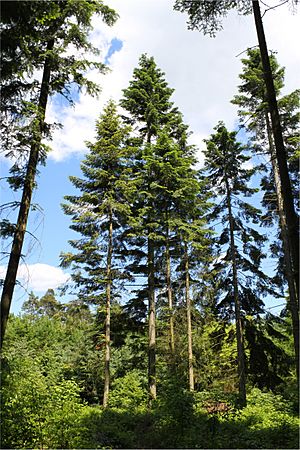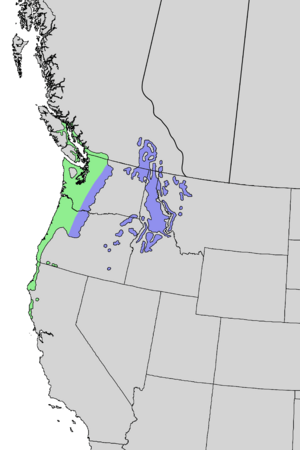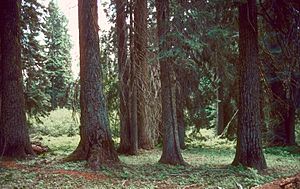Grand fir facts for kids
Quick facts for kids Abies grandisGrand fir |
|
|---|---|
 |
|
| Conservation status | |
| Scientific classification | |
| Genus: |
Abies
|
| Species: |
grandis
|
 |
|
| Natural range of Abies grandis
green - A. grandis ssp. grandis
blue - A. grandis ssp. idahoensis
|
|
The Abies grandis is a tall tree known by many names, like grand fir, giant fir, and lowland white fir. It's a type of fir tree that grows naturally in the Pacific Northwest and Northern California in North America. You can find it from sea level up to 1,800 meters (about 5,900 feet) high. It's a common tree in the Cascade Range.
These trees usually grow 40 to 70 meters (131-229 feet) tall. They might even be the tallest type of fir tree in the world! There are two main kinds, or varieties, of grand fir. The coast grand fir grows taller and is found west of the Cascade Mountains. The interior grand fir is shorter and lives east of the Cascades. A Scottish explorer named David Douglas first described this tree in 1831.
The grand fir is very similar to the white fir. People have used its bark for medicine in the past. Today, it's a popular choice for a Christmas tree in the United States. Its wood is a softwood and is often called "hem fir" in the timber industry. It's used to make paper and for building things like house frames and floors. Builders like it because it doesn't split or splinter easily.
Contents
Discovering the Grand Fir Tree
The grand fir was first found and described by a Scottish explorer named David Douglas. In 1831, he collected samples of the tree near the Columbia River in the Pacific Northwest.
What Does a Grand Fir Look Like?
The Abies grandis is a large evergreen coniferous tree. This means it keeps its needles all year round. It can grow to be 40 to 70 meters (131-229 feet) tall, and some have even reached 100 meters (328 feet)! Its trunk can be up to 2 meters (6.5 feet) wide.
The leaves are like needles, flat and about 3–6 cm (1-2 inches) long. They are shiny dark green on top. On the underside, they have two green-white stripes. The needles are arranged in a spiral around the branch. However, they twist at their base so they mostly lie flat in two rows on each side of the branch. This flat arrangement of different length needles helps you tell this tree apart from others.
The cones are 6–12 cm (2-5 inches) long and 3.5–4.5 cm (1.4-1.8 inches) wide. They have about 100-150 scales. The seeds inside have wings and are released when the cones break apart. This happens about six months after the tree is pollinated.
Types of Grand Fir Trees
There are two main types, or varieties, of grand fir. Scientists sometimes think of them as subspecies:
- Abies grandis var. grandis: This is the coast grand fir. It grows in coastal lowland forests, from sea level up to 900 meters (2,950 feet) high. You can find it from Vancouver Island in British Columbia, Canada, down to Sonoma County, California, United States. This tree grows very fast and can reach 70 meters (229 feet) tall. Its needles are very flat on all branches. It can handle winter temperatures down to about -25° to -30 °C (-13° to -22 °F). When young, it can grow over 1.5 meters (5 feet) per year in good spots.
- Abies grandis var. idahoensis: This is the interior grand fir. It lives in forests further inland, at 600–1800 meters (1,970-5,900 feet) high. It's found on the east side of the Cascade Range in Washington and northern Oregon. It also grows in the Rocky Mountains from southeast British Columbia south to central Idaho, northeast Oregon, and western Montana. This tree is smaller and grows slower, usually reaching 40–45 meters (131-148 feet) tall. Its needles are not as flat and often stick up from the branch, especially on the upper parts of the tree. It can handle much colder winter temperatures, down to about -40 °C (-40 °F). It grows slower, usually less than 0.6 meters (2 feet) per year even when young.
The grand fir is very closely related to the white fir. The interior grand fir (var. idahoensis) is especially similar to the white firs found in western Oregon and California. They even mix together where their growing areas meet in the central Oregon Cascades.
How People Use Grand Fir
Some Native American tribes used the inner bark of the grand fir. They would use it to help treat colds and fever. The needles have a nice smell, like citrus fruit. Because of this, grand fir branches are sometimes used for Christmas decorations, and the trees themselves are popular Christmas trees in the United States. People also plant them as pretty trees in large parks.
The Okanagan-Colville tribe used it as a "strengthener's drug" when people felt generally weak.
Grand Fir Wood: "Hem Fir"
The wood from the grand fir does not have much resin and has a fine texture.
In the North American logging industry, grand fir wood is often called "hem fir." This is a general name for wood from several different tree species that are used in similar ways. These include the California red fir, noble fir, Pacific silver fir, white fir, and western hemlock. Grand fir wood is often shipped along with these other types. It can also be called "white fir" lumber, which is another general term for wood from Abies amabilis, Abies concolor, and Abies magnifica.
Wood from the grand fir is considered a softwood. It's used for making paper, packing crates, and for building. "Hem fir" is often used for framing in buildings. It's strong enough to meet the building code requirements for many construction projects.
Compared to other types of wood used for building, "hem fir" is a bit less strong than the "Douglas fir-larch" combination. However, it's stronger than other common wood types like "Douglas fir-South" and "spruce-pine-fir (South)." Because it's almost as strong as Douglas fir-larch, it's often used for the main support structures in homes, small businesses, and larger buildings. Builders often prefer "hem fir" because nails and screws hold well in it without the wood splitting. It also doesn't splinter much when it's sawed.
Images for kids
See also
 In Spanish: Abeto de Vancuver para niños
In Spanish: Abeto de Vancuver para niños







